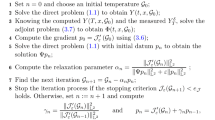Abstract
A boundary identification problem in inverse heat conduction is studied, based on data from internal measurement of temperature and heat flux. Formulated as a sideways heat conduction equation, a spatial continuation technique is applied to extend the solution to a known boundary condition at the desired boundary position. Recording the positions traversed in the continuation for each time instant yields the boundary position trajectory and hence the solution of the identification problem. A prospective application of the method can be found in the ironmaking blast furnace, where it is desired to monitor the thickness of the accreted refractory wall based on measurement of its internal state. Simulations featuring noisy measurement data demonstrate the feasibility of the identification method for blast furnace wall thickness estimation.












Similar content being viewed by others
Abbreviations
- C :
-
space-marching matrix, Eq. 15
- \(\mathcal{D}\) :
-
computational domain, Fig. 1
- I :
-
identity operator/matrix, Eq. 13
- L 2 :
-
Hilbert space, Eq. 16
- M :
-
bound for boundary temperature, Eq. 17
- N :
-
discrete time interval number, Eq. 8
- q :
-
measured heat flux, Eq. 2
- s :
-
boundary trajectory, Eq. 1
- S :
- t :
-
time, Eq. 1
- T :
-
temperature, Eq. 1
- u :
-
measured temperature, Eq. 2
- U :
-
temperature, Eq. 8
- x :
-
co-ordinate, Eq. 1
- Δ:
-
difference, Eq. 10
- ε:
-
measurement error, Eq. 16
- m:
-
measurement, Eq. 2
- N :
-
endpoint, Eq. 1
- q :
-
heat flux, Eq. 16
- s :
-
boundary, Eq. 3
- T:
-
transpose, Eq. 9
- u :
-
temperature, Eq. 16
References
Alifanov OM (1994) Inverse heat transfer problems, international series in heat and mass transfer. Springer, Berlin Heidelberg New York
Engl HW (1993) Regularization methods for the stable solution of inverse problems. Surv Math Ind 3:71–143
Berntsson F (2001) Numerical methods for solving a non-characteristic Cauchy problem for a parabolic equation. Technical Report LiTH-MAT-R-2001-17, Department of Mathematics, Linköping University, Linköping
Eldén L (1997) Solving an inverse heat conduction problem by a “method of lines”. Trans ASME 119:406–412
Richtmyer RD, Morton KW (1967) Difference methods for initial-value problems, tracts in pure and applied mathematics, 2nd edn. Wiley Interscience, New York
Carasso A (1982) Determining surface temperatures from interior observations. SIAM J Appl Math 42:558–574
Levine HA (1983) Continuous data dependence, regularization, and a three lines theorem for the heat equation with data in a space-like direction. Ann Mat Pura Appl 134:267–286
Eldén L (1995) Numerical solution of the sideways heat equation. In: Engl HW, Rundell W (eds) Proceedings of the GAMM-SIAM Symposium, Gesellschaft für Angewandte Mathematik und Mechanik. GAMM-SIAM, Regensburg
Carasso AS (1994) Overcoming Hölder continuity in ill-posed continuation problems. SIAM J Num Anal 31:1535–1557
Carasso AS (1999) Logarithmic convexity and the “slow evolution” constraint in ill-posed initial value problems. SIAM J Math Anal 30:479–496
Carasso AS (1992) Space marching difference schemes in the nonlinear inverse heat conduction problem. Inverse Probl 8:25–43
Carasso AS (1993) Slowly divergent space marching schemes in the inverse heat conduction problem. Numer Heat Transfer B 23:111–126
Fredman TP (2002) Accretions in the blast furnace stack—background factors. Can Metallurgical Q 41:475–486
Fredman TP (2002) Accretions in the blast furnace stack—diagnosis, modeling and control. Can Metallurgical Q 42:61–70
Author information
Authors and Affiliations
Corresponding author
Rights and permissions
About this article
Cite this article
Fredman, T.P. A boundary identification method for an inverse heat conduction problem with an application in ironmaking. Heat Mass Transfer 41, 95–103 (2004). https://doi.org/10.1007/s00231-004-0543-3
Received:
Published:
Issue Date:
DOI: https://doi.org/10.1007/s00231-004-0543-3




